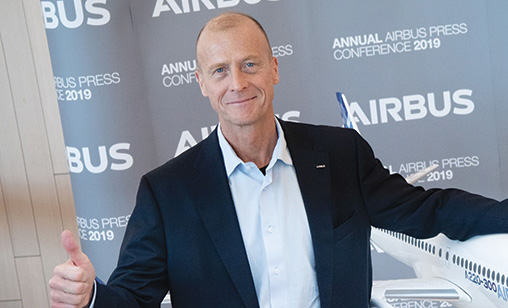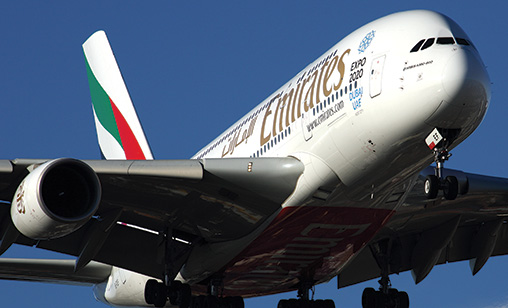News Backgrounder
A queen of the skies abdicates
It was the giant aircraft that was going to change air travel. It did bring new levels of comfort to its passengers, but the days of the A380 are numbered after its European manufacturer took the momentous decision to cease deliveries from 2021. Chief correspondent, Tom Ballantyne, reports on the reasons behind the decision.
March 1st 2019
For Airbus chief executive, Tom Enders, it was a heart-wrenching moment when he announced last month that deliveries of the flagship A380 would come to an end in 2021. Read More » Set to step down from the leadership of the European aerospace group at the annual shareholder meeting next month, his February announcement was an admission that the long battle to keep the A380 alive was lost. Just 12 years after the four engine aircraft entered into service, its fate was sealed.
“In 2000, when we took the decision to launch the A380, we did not know what the market would look like 20 years later,” he said. “This is a painful decision for us. We have invested a lot of effort, a lot of resources and a lot of sweat. But obviously we need to be realistic.”
 |
| 'The A380 is not only an outstanding engineering and industrial achievement. Passengers all over the world love to fly on this great aircraft. Hence today’s announcement is painful for us and the A380 communities worldwide' |
| Tom Enders Airbus CEO |
Reality was that Airbus was manufacturing, at huge cost, an aircraft no airline, apart from Dubai’s Emirates Airline now wanted. Existing A380 operators also had made it clear to Toulouse they would not acquire more of the type.
The end could have come a year earlier but for Emirates. In a program saving deal in January 2018, the Gulf carrier ordered 36 more A380s, for an estimated US$16 billion, which brought its commitment to the jet to 178 aircraft, at list prices of $60 billion.
In February, after months of unproductive talks, the final blow to the program was Emirates’s decision to reduce its A380 order book by 39 aircraft and instead purchase 40 A330neo and 30 A350s.
The Gulf carrier will take delivery of 14 more A380s in the next two years. “As a result of this decision, we have no substantial A380 backlog and hence no basis to sustain production, despite all our sales efforts with other airlines in recent years. This leads to the end of A380 deliveries in 2021,” Enders said.
Why has the A380 dream come to this? The jet was touted as the high-capacity, long-term replacement for the iconic 747 that also introduced unprecedented levels of comfort to airline passengers. Spearheaded by the company’s aggressive sales chief, John Leahy, Airbus argued forcibly that airlines would have no choice but to buy it because increasingly congested airports and slot shortages meant they must carry more passengers in fewer planes. It reaped early orders from market leaders Singapore Airlines and Qantas Airways as well as Emirates.
Quickly it became clear a majority of airlines were reluctant to invest in the A380. In more than a decade, it only won 313 orders. Not a single U.S. airline wanted the plane. In China, the world’s fastest growing airline market, only China Southern Airlines committed to the type with six orders.
Apart from the Emirates deal 14 months ago, All Nippon Airways recently ordered three of the type. The Japanese carrier will operate them exclusively on the heavily-trafficked leisure route from Japan to Hawaii.
Even existing A380 operators backed away from more sales. Shortly before the Airbus announcement of the program’s closure, Qantas revealed it had formally cancelled a longstanding order, placed in 2006 for eight more A380s.
Singapore Airlines has long made it clear it did not need any more. Last June, it returned two to lessor, Dr. Peters Group. The German investment company failed to find new customers for the aircraft and eventually decided to sell them for parts.
Malaysia Airlines Berhad has been trying to either offload its six A380s or transfer them to a new company, Project Amal, that is planned to operate Hajj flights to the Middle East. Last November, Air France reduced its A380 fleet by 50% when it did not renew leases on the aircraft.
At press time, there were 218 active, 11 parked and three stored A380s, consultancy IBA said last month. Emirates has a fleet of 66 owned and 43 leased of the type, which makes up 47% of the global fleet. SIA has 16 owned and three leased A380s. A majority of A380 operators are full service carriers.
Following the news that production of the A380 would cease, analysts were unanimous in their views that the decision was inevitable, given that no single aircraft can survive by relying on a single customer.
 |
“In an industry characterized by razor thin margins, the A380’s four-engine configuration, high fuel consumption and enormous weight made the plane expensive to run on top of its eye-watering average procurement cost of $445 million,” said GlobalData head of travel & tourism, Nick Wyatt.
“The loss of the A380 is undoubtedly a setback for Airbus with the plane superseded by planes like the A350, the A330 and Boeing’s 787. They all offer greater fuel efficiency, but can still carry large passenger numbers over a comparable range to exploit the trend for end-to-end flights.
“Airbus gambled on a continuation and maybe even an increase in hub-and-spoke flying. Although the 787 has not killed that model in the way many predicted, hub-and-spoke is unpopular in an era defined by time poverty. Smaller jets flying direct showcase the limitations of hubs.”
Others agreed. Airlines today are focusing on expanding their networks with non-stop point to point strategies rather than flying passengers via one-stop hubs. New generation twin-engine, twin-aisle long-haul aircraft such as the A350, 787 and 777 enable them to do that. In the same decade, Boeing took a defensive play against the A380 with the 747 Continental. In passenger terms, it also was a failure and is now only produced as a freighter.
The end of A380 deliveries presents other challenges. It is a blow to the European aerospace industry and a threat to as many as 3,500 jobs at Airbus. Airbus will start discussions with unions on this front, but it is understood the ramp-up in production its popular A320 and the new widebody order from Emirates will offer a significant number of “internal mobility” opportunities.
Lessors and owners of A380 investment funds will be unsettled by the decision because it may impact the resale value of the aircraft. IBA said “an aspect to consider in any remarketing situation is the high cost of transition that would be necessary to place it [an A380] into service with an alternative carrier”. The transition alone presents numerous obstacles to LCC business models, it said.
Analysts pointed out the aircraft was not making money and accounted for only two per cent of the manufacturer’s aircraft deliveries in 2018. The financial costs of the program look manageable. Airbus’s full-year profit suffered a net $522 million hit from the cancellation, but said it expected a neutral impact on free cash flow in the next three years.
By announcing the decision now incoming chief executive, Guillaume Faury, can focus on the more profitable A320 and A350, which together make up about nine of every 10 Airbus deliveries.
None of this meant the A380 was a poor aircraft.“Keep in mind A380s will roam the skies for many years to come and Airbus will continue to fully support A380 operators,” said Enders. Faury said the A380 is Emirates’ flagship and has contributed to the airline’s success for more than 10 years.
“As much as we regret the airline’s position, selecting the A330neo and A350 for future growth is a great endorsement of our very competitive widebody aircraft family. Going forward, we are fully committed to deliver on the longstanding confidence Emirates is placing in Airbus,” Faury said.
Emirates Airline Group chairman and CEO, Sheikh Ahmed bin Saeed Al Maktoum, said the airline had been a staunch supporter of the A380 since its very inception. “While we are disappointed to have to give up our order and sad the program could not be sustained, we accept this is the reality of the situation,” he said.
“For us, the A380 is a wonderful aircraft loved by our customers and our crew. It is a differentiator for Emirates. We have shown how people can truly fly better on the A380. Emirates has set the standard for that by introducing customer experiences unique to the A380 like our Shower Spas and Onboard Lounge.
“The A380 will remain a pillar of our fleet well into the 2030s and as we have always done, Emirates will continue to invest in our onboard product and services so our customers can be assured the Emirates A380 experience will always be top-notch.”
The Emirates chairman said the decision to purchase A330neos and A350s was part of a fleet strategy to operate a young, modern and efficient all-wide body fleet that remained unchanged. “The 40 A330neos and 30 A350s we are ordering will complement Emirates’ fleet mix, support our network growth and give us more flexibility to serve seasonal or opportunistic demand. Both the A330neos and A350s will play an important role in our future fleet and network plans.”
The A330neos will fly Emirates’ regional network and enable the airline to serve smaller airports that will open new routes and connectivity for its global network. The A350s will supplement Emirates’ long-haul operations, providing the carrier with added flexibility in capacity deployment on eight to 12-hour flights from its Dubai hub.